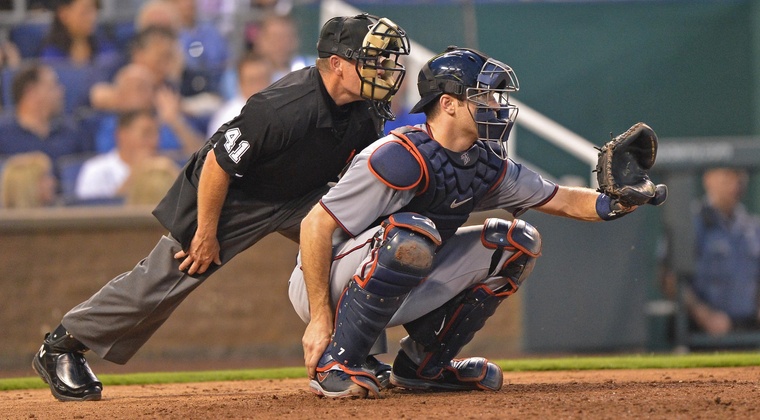There is a general feeling among baseball fans that former catchers make the best baseball managers. And if you look at recent history, it’s not too hard to see why some people think that.
After all, Bruce Bochy led the Giants to the World Series in 2014, and he’s a former catcher. And if you rewind the clock to 2009 (covering the last six seasons), catchers have won 67 percent of the World Series, with Bochy doing it three times.
In fact, the 21st century started out with three ex-backstops leading their teams to the World Series Championship: Joe Torre (Yankees) in 2000, Bob Brenly (Diamondbacks) in 2001 and Mike Scioscia (Angels) in 2002.
Who’s at the helm of Major League Baseball teams right now, you ask?
That means that 43% (close to half) of big league managers in 2015 are former catchers. No wonder teams have been stockpiling catcher-managers.
You gotta be nuts to catch. Or brilliant.
They used to refer to a catcher’s gear as the tools of ignorance because, the thinking was, you’d have to be a touch out of your mind to voluntarily suit up, get behind the plate and catch for a whole game (let alone season after season)—it’s a painful job that a “smart” ballplayer avoids. Well, the tools of ignorance are being used to craft careers as managers. Sure, not every former catcher-turned-manager has been successful, but then again, how many managers reach the pinnacle anyway?
With ex-catchers doing so well lately, it’s easy to conclude that they bring something special to the dugout—there must be a reason for their success. That’s what owners and general managers are concluding as well.
Why do catchers make good skippers?
It’s easy to understand why people “peg” catchers as potentially good managers:
You can’t make the same argument for the other position players. A starting pitcher throws once every four to six days. Even the closer who pitches all the time doesn’t have to wake up from his nap until the 8th inning.
Here’s what one former catcher, Steve Yeager of the ’70s Dodgers (and who’s not a manager), said about current Dodger catcher A.J. Ellis and the skills Ellis possesses that make him potential skipper material:
“Being a catcher, and they always say that catchers make pretty good managers, we see the overall view of what’s going on out on the field. We see the defense, we see the offense, we see the hitter, we have conversations and communications with the pitchers, so we’re always working, always thinking. And in some cases you’re thinking a couple hitters ahead and a couple pitches ahead, one pitch sets up another pitch, one location sets up another location, so you’re thinking all the time. A.J. does all of these things extremely well and I think he would make a terrific manager.”
The catcher is like the quarterback in football…the field general. And if nothing else, a catcher learns to live and work with umpires better than anyone else on the team. A catcher spends time behind the plate with the home plate umpire breathing down his neck. Also, it’s rare to see catchers really lose their cool. They know how to keep the peace and maintain focus. They are models for an even temperament.
Just think of all the multitasking the catcher has to do while the infielders and outfielders are simply waiting to get back to the dugout to get more sunflower seeds:
You could look it up.
About a decade ago, a writer compiled statistics about every MLB manager going back 130 years, comparing regular and World Series games managed and won. But specifically, he examined the records of all the managers that were former catchers. At the end of the exercise, here was his conclusion:
Catchers made the worst managers, statistically. The numbers ranked them, as a group, behind other managers who were infielders, outfielders…and even pitchers.
Those purely statistic-based results led him to speculate why it had ever become so popular to hire catchers as managers. He even went on to wonder if catchers, whom he considered bossy and opinionated, “just talk a good game.” The results, (happily for him) seemed to match his personal opinion that catchers didn’t really make “great” managers.
You could look it up. Part 2.
In 2011, the St. Louis Cardinals hired Mike Matheny (an ex-catcher) to replace Hall of Fame manager Tony LaRussa (a former infielder). A Web blogger at the time wrote an article warning fans not to get excited simply because Matheny was a former backstop. He told Cardinal fans they should be very worried about the team’s future. In the blogger’s opinion, “the numbers seemingly debunk the myth” that catchers are great managers. He predicted Mike Matheny would fail, big time.
So, just how has Mike Matheny performed at the helm of the St. Louis Cardinals?
In his first four managerial years, he’s made it to the National League Championship Series three times (2011, 2013, and 2014) and the World Series once (2012). As of July 2015 (when this was written), the Cardinals were leading the National League’s Central Division by 4.5 games.
You could look it up.

